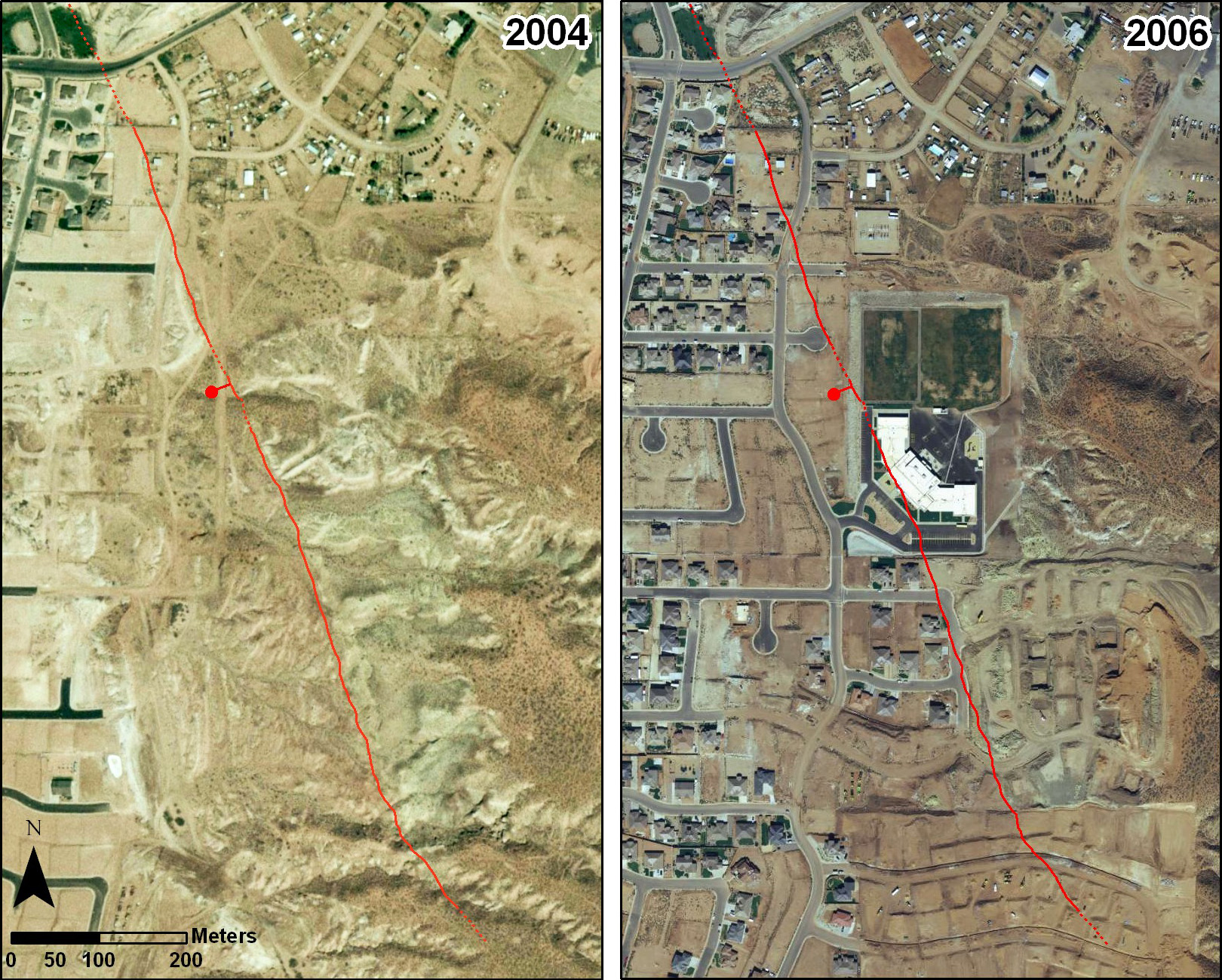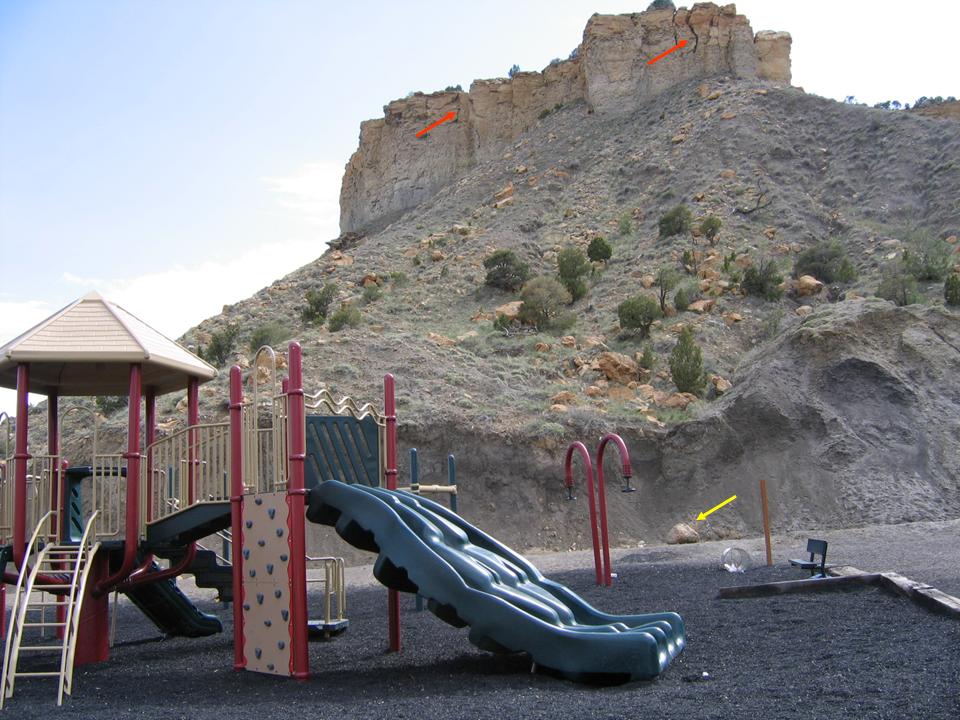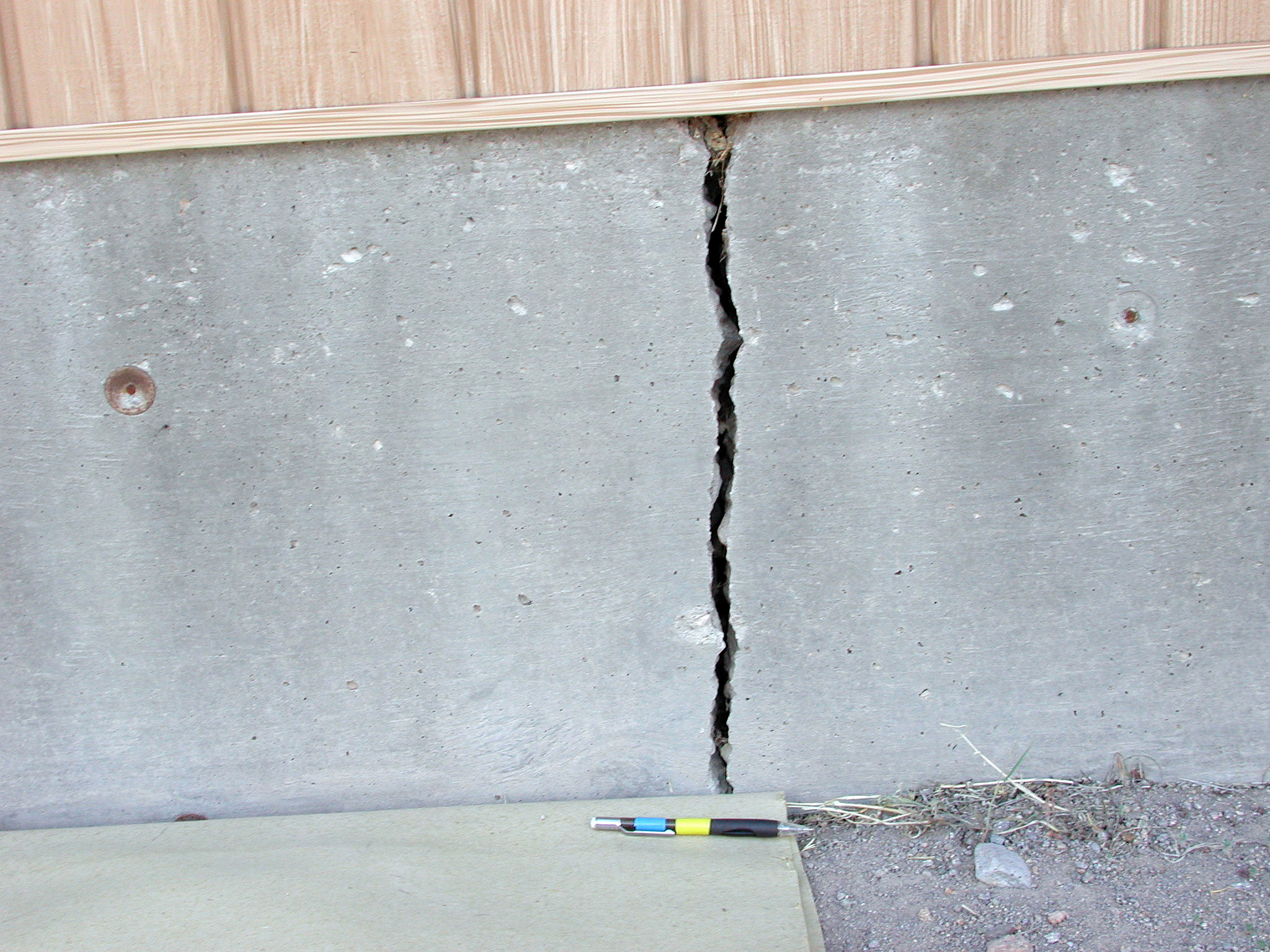School Site Evaluation and Report Review Services

2004 and 2006 National Agricultural Imagery Program aerial photography of before and after the construction of a school in Washington City, Utah, showing the Washington fault (in red) crossing the school site and adjacent residential building pads. Proper land-use planning and pre-design and construction geologic-hazard investigations should have been performed to determine adequate building setback requirements.
To ensure that proposed school building sites are investigated for potential geologic hazards, the Utah State Office of Education (USOE) recommends a preliminary site screening evaluation by the UGS, the preparation of detailed geologic-hazard reports by professional consultants (employing Utah licensed geologists) retained by the school district, and subsequent review of those geologic-hazard reports by the UGS.
The purpose of the geologic-hazard report review is to ensure that site-specific geologic-hazard investigations are sufficiently thorough, that the report conclusions regarding any identified geologic hazards are valid, that proposed mitigation measures are reasonable, and that geologic hazards are addressed uniformly and effectively throughout the state. The purpose of the preliminary site screening evaluation is to identify any significant geologic hazards that should be considered in the decision making process for school-site selection.
The on-line USOE School Building Construction and Inspection Resource Manual contains additional information related to USOE requirements for school construction. Also, see the Utah State Office of Education – Geologic-Hazard Report Guidelines and Review Checklist for New Utah Public School Buildings.
Preliminary School Site Screening and Evaluation
During the initial school site selection process, the UGS performs preliminary site screening evaluations prior to design and construction to identify any significant geologic hazards that should be considered in the school-site selection process.

Rockfall hazard above a Price area school. Note large boulders on the slope below the cliff and a boulder (yellow arrow) that rolled down to the graded area behind the children’s play area. Cliff contains numerous tension cracks (red arrows) that could produce rock fall.
This evaluation consists of a general literature review of existing geologic information published or housed by the UGS and other information that may be available. The evaluation will be summarized in a report that typically identifies the potential for earthquake ground shaking, surface fault rupture, liquefaction, tectonic subsidence, landslides, rock fall, earthquake-induced flooding, debris flows, collapsible soils, expansive soil and/or rock, erodible soils and/or rock, shallow groundwater and/or bedrock, flooding (such as from streams, lakes, canals, and/or dam failures), karst conditions, wind-blown sand, and indoor radon.
A site visit is typically not required, except for unusual site conditions, or upon request. To request a preliminary school-site screening evaluation, contact the UGS School Site Review Coordinator (see below) for your particular site location.
| UGS Preliminary School Site Screening Evaluation Fees | ||
|---|---|---|
| School Sites | Fee | Travel (if required) |
| One School | $550.00 | Current State Travel Rates |
| 2-3 Sites in Same City/Area | $750.00 | |
| Special Conditions (additional costs) | $40.00/hr | |
The preliminary school site screening evaluation report should be used during the school site selection process to determine if any significant geologic hazards may be present at a particular site, and if so, to help determine if the geologic hazards can be properly and cost-effectively mitigated during design and construction.
The evaluation report should also be provided to the design team, including the project geotechnical consultant, to help guide geologic-hazard and geotechnical investigations. A Phase I Environmental Site Assessment, performed by professional environmental consultants following the ASTM E1527 standard, is also recommended to determine the land-use history and other related issues at a particular site.
Geologic Hazard Reports and UGS Review

1998 fault trench for the proposed C. Roland Christensen Center on the University of Utah campus as part of a pre-design and construction fault investigation project by a local engineering consultant.
Once a preliminary school site screening evaluation has been performed and a school-site selected, a geologic-hazard report should be prepared by a professional consultant licensed in Utah. This report may be combined with a geotechnical report, but at a minimum, must include the information detailed in the geologic-hazard report guidelines.
Report guidelines and review checklist have been prepared to assist in the preparation of geologic-hazard reports for new Utah public school buildings, to facilitate the review of those reports by the UGS, and to provide feedback related to geologic hazards to school-site development consultants. The guidelines and checklist also contain information on geologic-hazard data sources, a list of references cited, and a brief geologic-hazard glossary.
The UGS will review geologic-hazard reports from a geologic perspective; however, if hazard evaluation or risk reduction measures include engineering analyses, design, and/or recommendations, a Utah-licensed Professional Engineer specializing in geotechnical engineering must review them.
To request a geologic-hazard report review, contact the UGS School-Site Review Coordinator (see below) for your particular site location.
| UGS Geologic-Hazard Report Review Fees | ||
|---|---|---|
| Report | Fee | Travel (if required) |
| Per Report | $500.00 | Current State Travel Rates |
| Special Conditions (additional costs) | $40.00/hr | |
During the review process, the UGS School-Site Review Coordinator will review each submitted geologic-hazard report for pertinent information related to 16 items associated with the project and geologic hazards as indicated on the checklist, determine if the report adequately addresses each item, and provide brief comments on the item, if needed.
Utah School-Site Review Contacts

Example of foundation damage resulting from unmitigated collapsible subgrade soils. Unmitigated problem soils, such as collapsible, compressible, and expansive soils can lead to excessive differential movement of foundations, resulting in high building maintenance and repair costs.
Utah Geological Survey (UGS), Geologic Hazards Program
Program Manager – Steve Bowman [(801) 537-3304], stevebowman@utah.gov
For Northern/Central Utah (Box Elder, Cache, Carbon, Daggett, Davis, Duchesne, Emery, Grand, Juab, Millard, Morgan, Rich, Salt Lake, Sanpete, Sevier, Summit, Tooele, Uintah, Utah, Wasatch, and Weber Counties):
School Site Review Coordinator – Richard Giraud [(801) 537-3351], richardgiraud@utah.gov
Utah Geological Survey
1594 West North Temple, Suite 3110
P.O. Box 146100
Salt Lake City, Utah 84114-6100
(801) 537-3300, FAX (801) 537-3400
For Southern Utah (Beaver, Garfield, Iron, Kane, Piute, San Juan, Washington, and Wayne Counties):
School Site Review Coordinator – William Lund [(435) 865-9034], billlund@utah.gov
Utah Geological Survey
Southern Utah Regional Office
88 East Fiddler Canyon Road, Suite C
Cedar City, Utah 84721
(435) 865-9034, FAX (435) 865-9037
Utah State Office of Education (USOE), School Finance & Statistics Program
School Construction Inspection Specialist – Jenefer Youngfield [(801) 538-7669], jenefer.youngfield@schools.utah.gov
250 East 500 South
Salt Lake City, Utah 84114
(801) 538-7500, FAX (801) 538-7729



